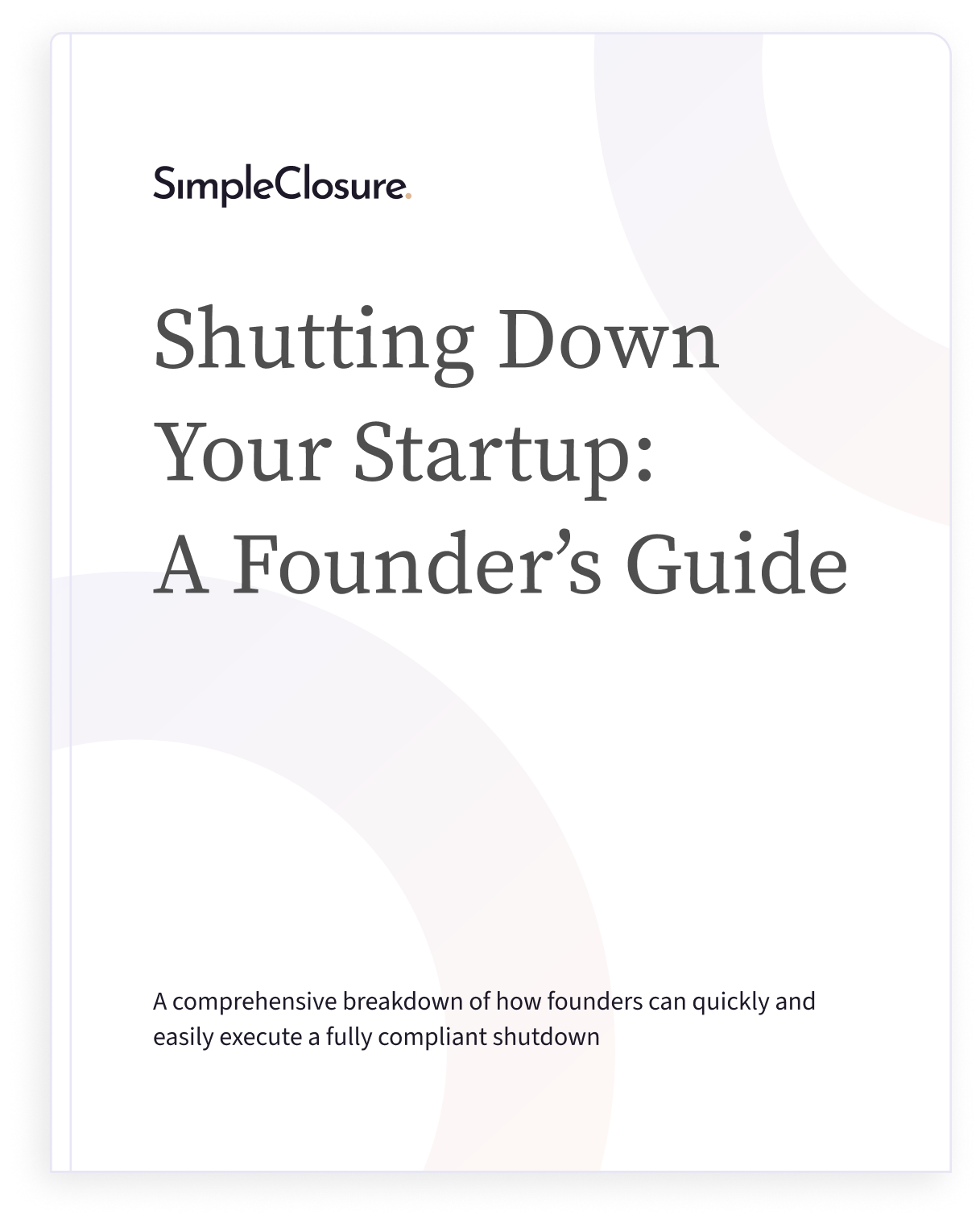Deciding how to exit a startup can be as tough as starting it. With so many options to consider, the fear of taking the wrong step can prevent you from exiting at the right time.
So, here’s a simplified guide that explains the complex world of exit strategies. Because no two startups are the same and the reasons for exiting differ, we’ve classified each exit strategy under the growth-oriented, alternative and niche, or winding-down and recovery stages.
Each option also has its pros and cons so you can make the best decision for you and your stakeholders.
1. Growth-Oriented Exit Strategies
Merger or Acquisition (M&A)
A merger or acquisition takes place when two companies become one, either via merging or one buying the other. The combined strength of both startups allows the new company to accelerate growth and reach more customers. It's not just about getting bigger; it's about becoming more formidable together.
Pros:
Direct financial gain for you and your investors, rewarding your hard work.
Access to a broader customer base and distribution network, enabling growth.
Opportunity to scale quickly and enter new markets with the backing of a larger entity.
Cons:
Potential loss of control over how your startup business operates.
Challenges in merging different company cultures and systems.
Risk of downsizing, negatively affecting some team members.
Example: Salesforce's acquisition of Slack Technologies, Inc. in 2021.
Initial Public Offering (IPO)
An IPO is when your company goes public, allowing anyone to buy a piece of your startup. The biggest upside of an IPO is that it helps raise significant capital and speeds up innovation and expansion in a way that wasn’t possible before. Going public also puts you in the spotlight and offers a unique opportunity to elevate your startup’s profile on a global stage.
Pros:
Raises capital to accelerate growth and expand operations.
Increases your company’s visibility and credibility.
Provides an opportunity for early investors to cash out at a profit.
Cons:
The process is complex, costly, time-consuming, and has plenty of regulatory hurdles.
Public companies face constant scrutiny from shareholders and the market.
The pressure to meet short-term financial targets can potentially hamper your long-term goals.
Example: Snapchat's parent company, Snap Inc., went public in March 2017.
Secondary Market Sale
Selling shares on the secondary market to gain liquidity is a quieter alternative to an IPO. It lets founders and early investors sell their stakes to private investors without the fanfare or scrutiny of going public. It also helps establish an early market value for the company, making it easier to manage financial transactions or gain additional investor funding down the road.
Pros:
It’s a faster way to access funds without the complexities of an IPO.
Avoids the public scrutiny and regulatory hurdles of the public market.
Helps set a valuation for your company in the eyes of future investors or buyers.
Cons:
Might not achieve the same valuation as an IPO or direct acquisition.
Finding buyers can be challenging and requires the right connections.
Could lead to dilution of your stake or possible changes in how the company operates depending on the new investors.
Example: Spotify's shares were traded on secondary markets before its direct listing in 2018.
Strategic Acquisition
Sometimes, the startup you’ve built aligns so perfectly with another company's needs that they're willing to buy your company outright, resulting in a strategic acquisition. The main attractor could be the team, technology, or market position. Whatever the case may be, being acquired offers a chance to innovate and scale rapidly, backed by the resources and network of a larger, established company.
Although your startup will no longer operate independently, the impact of your work could be magnified on a much larger scale.
Pros:
Typically results in a good valuation due to the strategic fit.
Your work gets propelled forward with more resources and a larger platform.
Offers new opportunities for the team within a larger organizational structure.
Cons:
Your vision for the company may shift under new ownership.
Integrating into a larger company’s culture and processes can be challenging.
The acquisition process can be lengthy and divert focus from day-to-day operations.
Example: Amazon's acquisition of MGM Studios in 2021 to enhance its streaming content library.
2. Alternative and Niche Strategies
Management Buyout (MBO)
A Management Buyout (MBO) is when the startup’s existing management team purchases the majority or all of the company's assets and operations, effectively taking ownership from the current owners or shareholders. It allows the most capable people who are already familiar with the startup’s operations, culture, and strategic goals to steer the startup company in the right direction.
Pros:
Smooth transition with minimal disruption to operations.
Preserves the existing company culture and vision.
Empowers the management team with ownership and decision-making freedom.
Cons:
Financing the buyout can be challenging, often requiring significant debt.
Potential conflicts of interest during the negotiation process.
Pressure on the management team to perform with added financial responsibilities.
Example: Dell's CEO Michael Dell and Silver Lake Partners' buyout of Dell in 2013.
Private Equity Acquisition
A private equity firm acquires your startup with plans to optimize operations, possibly merge it with other companies, or prepare it for a big future exit. Think of it as partnering with a seasoned team that brings a strategic plan to elevate your startup business to new heights.
Pros:
Immediate financial exit for founders and early investors.
Access to capital and expertise to scale or restructure.
Opportunity for a second, more significant exit in the future.
Cons:
The firm may make major changes to align with its investment strategy.
Increased pressure to deliver short-term financial performance.
Possible loss of company identity or culture post-acquisition.
Example: Medline Industries being acquired by a consortium of private equity firms including Blackstone, Carlyle, and Hellman & Friedman in 2021.
Employee Stock Ownership Plan (ESOP)
An Employee Buyout (EBO) is when the employees, not just the management, come together to purchase the startup. It democratizes ownership and spreads it across the workforce rather than concentrating it among top managers, as in an MBO.
Pros:
Strengthens employee commitment and motivation by giving them ownership.
Provides a tax-efficient exit strategy for founders.
Helps preserve the company’s culture and legacy.
Cons:
Complex setup process with significant administrative overhead.
Not a liquid market for employees wanting to sell shares.
Requires transparent financial management and can limit strategic flexibility.
Example: New Belgium Brewing becoming 100% employee-owned through an ESOP in 2012.
Acqui-hire
Sometimes, it's not the product but the people behind it that companies want. An acqui-hire focuses on bringing your talented team on board with another company, ensuring their skills are put to good use in new projects.
Pros:
Provides a soft landing for the team with continued employment opportunities.
Can offer a way out for founders when their product or service hasn’t hit the mark.
The acquiring company benefits from an experienced team that's ready to go.
Cons:
The original product or service may be shelved.
May not provide the same level of financial exit as other strategies.
Transitioning to a new company culture can be challenging for the team.
Example: Twitter's (now X) acqui-hire of the team behind the news aggregator and summary app, Brief, in 2021.
Corporate Spin-off
A Corporate Spin-off is when you decide to separate a division or segment of your startup into an independent entity. This strategy can enhance the value of the new unit by allowing it to focus on its core strengths and market opportunities.
Pros:
Allows each entity to focus on its core strengths, potentially increasing overall value.
Can attract investment specific to the spin-off’s market or technology.
Offers existing shareholders stakes in both entities, diversifying their investment.
Cons:
Initial setup and separation costs can be high.
Risk of losing synergies that benefited the parent company and spin-off when combined.
Market confusion or dilution of brand identity in the short term.
Example: eBay spinning off PayPal into a separate publicly traded company in 2015.
3. Winding-down and Recovery Strategies
Liquidation
This is the process of closing your startup company for good, selling off all assets to settle debts. It's a tough decision that marks the end of your company, but it ensures that your creditors are fairly compensated.
Pros:
Clears outstanding debts, offering a clean slate.
Provides a definitive end to a difficult situation, allowing you to focus on future ventures.
Ensures a legal and orderly winding down process, minimizing potential legal issues.
Cons:
Marks the definitive end of your business operations.
Likely to receive minimal returns on sold assets.
Might adversely affect your professional reputation and emotional well-being.
Example: The retail chain Toys "R" Us began liquidating its U.S. stores in 2018.
Bankruptcy - Chapter 7 (Liquidation Bankruptcy)
Chapter 7, or Liquidation Bankruptcy, involves shutting down your startup. It differs from the previous point insofar as a court oversees the entire process and appoints a trustee to liquidate assets and pay back creditors. It's a legally structured way to discharge debts and brings the startup entity to an end.
Pros:
Debts are cleared, offering relief from financial burdens.
The process is managed by a trustee, reducing your direct involvement in asset sale and creditor repayment.
Provides a legal framework that protects you from certain liabilities.
Cons:
Results in the complete closure of your business.
Has a lasting impact on your credit score and can affect future entrepreneurial efforts.
Public record of bankruptcy can influence your professional reputation.
Example: The iconic photography company Kodak filed for Chapter 7 for its UK operations in 2013.
Bankruptcy - Chapter 11 (Reorganization Bankruptcy)
Chapter 11 offers a lifeline to startups facing financial difficulties. Unlike options that lead to shutting down, Chapter 11 focuses on restructuring the company's debts under the protection of the bankruptcy court. It’s a chance to renegotiate terms with creditors, possibly reducing debt loads or extending repayment periods and starting the process of sustainable growth and recovery.
Pros:
Offers a chance to keep your startup alive and return to profitability.
Allows for renegotiation of debts and contracts under more favorable terms.
Provides an opportunity to reorganize the business structure for better efficiency.
Cons:
Complex and expensive legal process, requiring significant time and resources.
Requires approval from creditors, who may have different visions for the company’s future.
Continual legal and financial oversight until the reorganization plan is successfully completed.
Example: JCPenney filed for Chapter 11 in May 2020, aiming to restructure and emerge healthier financially.
Related reading: Understanding Positive and Negative Aspects of Bankruptcy in Startup Closure: A Comprehensive Guide
Conclusion
You’ve now gained a basic understanding of the different exit strategy options available for your startup.
Exploring different ways to close or change your startup can help you make smart choices. Remember, ending one venture smoothly means you can start another with a clear mind.
SimpleClosure makes ending a startup easy. We use smart technology and legal know-how to take the stress off your shoulders. Move on to your next project faster.
Get your free founder's guide to shutting down

A comprehensive breakdown of how founders can quickly and easily execute a fully compliant shutdown


